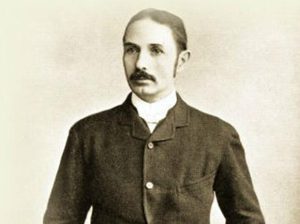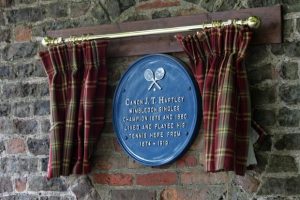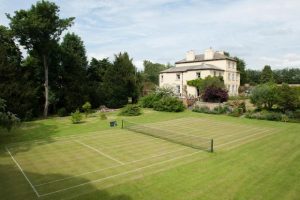From: Darlington & Stockton Times
John Hartley was born in Shropshire where his grandfather, George Thorneycroft, and his father, John Hartley, were industrialists and mayors of Wolverhampton. Our tennis-playing vicar eschewed their collieries and ironworks and preferred more spiritual concerns. He went to Harrow and Oxford, and in 1874, at the age of 25, was appointed to St Lambert’s Church at Burneston, near Bedale, where the living was controlled by the Duke of Cleveland, via his Leeming hunting lodge, Newton House (now lost beneath the aerodrome). The following year, the vicar married Alice Lascelles, the grand-daughter of the 3rd Earl of Harewood, and he practised his tennis. The All England Croquet Club held the first lawn tennis championships in 1877 in Wimbledon, and in 1879, Hartley paid one guinea to enter. The tournament started on Monday, July 7, and, perhaps surprising himself, on the Saturday, he won through to Monday’s semi-final, so he dashed home on the train to conduct the three Sunday services in St Lambert’s. Then one of his parishioners took a turn for the worse, and he sat with him into the early hours of Monday morning, administering the last rites as he slowly passed away. Job done, the vicar rushed back to Burneston Hall, collected some sandwiches from Alice, rode on horseback to Thirsk station, caught an express to King’s Cross, hailed a cab to Waterloo station from where he caught a slowtrain to Wimbledon, changing into his tennis gear in the carriage.
He arrived in the nick of time but, obviously out of breath, lost the first set. But God moves in mysterious ways. The heavens opened, and play was suspended. After the rain break, a refreshed Hartley won the next three sets 6-0, 6-1, 6-1 and reached the final, where he was to play Vere St Leger Goold. When asked in later life if he recalled this opponent, he said: “Yes, he was an Irish gentleman, named St Leger. I was given to understand that that was an assumed name. He was a pleasant, typical Irish gentleman of some refinement.” Goold was the younger son of a wealthy Irish baronet, and the final was a clash of styles. The flamboyant Irishman, who had spent the Wimbledon fortnight socialising enthusiastically, flashed into the net while the vicar remained soberly on the baseline, perfecting a new stroke – the lob – which won him the title, 6-2, 6-4, 6-2.
After the pair had shaken hands in front of the 1,100 spectators on Centre Court, Hartley returned to his North Yorkshire parish with the 12 guineas first prize and a silver cup worth 25 guineas, and Goold carried on with the high living. In 1907, the Irishman and his wife hacked a wealthy Swedish widow to death, jammed her headless body into a trunk and carried it – and her fortune – to the tables of Monte Carlo where they expected to clean up. Instead, the gendarmes followed a trail of blood to their hotel room and Goold became the only Wimbledon champion to be convicted of murder.
No such drama for Canon JT Hartley. He returned to Wimbledon in 1880 and successfully defended his title. In 1881, he reached his third successive final, but was up against William Renshaw, inventor of the violent overhead smash stroke. He made mincemeat of the vicar’s clever, but delicate, lob, and won 6–0, 6–1, 6–1 in 36 minutes. It is still the shortest Wimbledon final – but that must surely be because Hartley was suffering a touch of “the English cholera”. The vicar concentrated on tending his flock in Burneston until his retirement in 1919, and when he died in1935, he was buried beneath the churchtower. A blue plaque on his £1.5m hall tells of his extraordinary place in tennis history.


